
Tait 8100/8220 Radios
Model Codes and Identification
The product codes of the radio bodies have the format:
TMABbc–ddee[f]
where: ■ b identifies the architecture of the digital board: 1=conventional analog 2=conventional analog (dual-mode capability) 3 identifies the digital boards of the digital TM9100 product line. ■ c identifies the RF output power: 2=25W, 3=25W (trigger-base), 4=30 to 59W, 5=30 to 59W (trigger-base). ■ dd identifies the frequency band: A4=66 to 88MHz B1=136 to 174MHz C0=174 to 225MHz D1=216 to 266MHz G2 =350 to 400MHz H5=400 to 470MHz H6=450 to 530MHz H7=450 to 520MHz K5=762 to 870MHz (Tx)762 to 776MHz and 850 to 870MHz (Rx). ■ ee identifies any radio options: 00=BNC RF connector, 01=mini-UHF RF connector ■ f identifies a combination of software features as loaded at the time of manufacture
Power and Pin Out
If you need to create some new power-looms for your Tait 8200 series radios, finding Tait documentation for replacements is difficult. See below the connector and pin details.

This is the power and speaker connector used for 25W models of Tait TM8100 TM8200 TM9100 TM9300 TM9400 series mobile radios.
If you have a 30W++ model of these radios it is a different connector
Audio Output
If the radio has an external speaker connected it will disable the internal speaker.
The connector and pins are Molex derived, please see part numbers listed below.
| Item | Part-Number | Notes |
| Connector / Housing | Molex 39-01-4040 (Order Code: 9963499) | |
| Pin | Molex 45750-3112 (Order Code: 1717549) | 16AWG |
| Pin | Molex 45750-1112 (Order Code: 1717550) | 18AWG |

| PIN | SIGNAL NAME | DESCRIPTION | SIGNAL TYPE |
| 1 | AGND | Earth return for radio body power source | Ground |
| 2 | SPK – | External Speaker output. Balanced load configuration | Analog |
| 3 | SPK + | External Speaker output. Balanced load configuration | Analog |
| 4 | 13V DC | DC Power Input for radio body and control head | Power |
Recommendations
- Note the different size pins – Recommend considering what size pins you need for the power vs audio output (if applicable)
- If comparing to other radios (EG: Tait 2000s) you cannot use the same gauge wire, generally a lower gauge so consider patch harness / power loss etc.
Programming Cable
Available online are Tait 8200 Programming Cables for purchase, however you can make your own Programming Cable terminating into a Serial DB9 connector if required.
- For 8200 Units they’re programmed via the Microphone Port
- For units with HHCH (Hand-Held Control Head) they are programmed via a port in the hand-held piece.

As the microphone socket on any 8000s series is a RJ45 8P8C you could make your own but if you have a handy Tait 2000 programming cable around, can just use that. Make sure you plug it into the centre of the socket. (the additional two pins on either side are not utilised for programming.